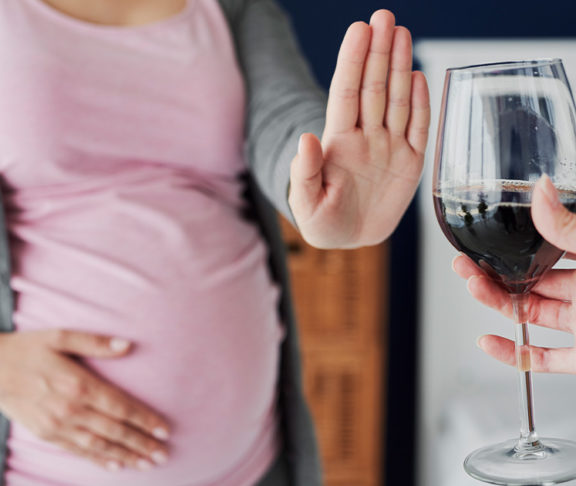
Vincent C. Smith, M.D., M.P.H., FAAP
Dr. Vincent C. Smith is Division Chief of Newborn Medicine at Boston Medical Center and Professor of Pediatrics at Boston University Chobanian & Avedisian School of Medicine. He serves as the Medical Director for the American Academy of Pediatrics’ Fetal Alcohol Spectrum Disorders Program.
Fetal alcohol spectrum disorders (FASDs) is an umbrella term used to describe preventable birth defects and intellectual/neurodevelopmental disabilities that can result from prenatal alcohol exposure. While we do not know exactly how many people have FASDs, it is estimated that as many as 1 to 5 per 100 school children may have FASDs.1
These effects can have lifelong implications that may result in intellectual or learning disabilities, behavior problems, or physical birth defects, as well as trouble learning life skills. Impacts may include, but are not limited to, brain abnormalities, memory problems, communication impairments, frequent or prolonged behavioral outbursts, delayed independence skills, and/or minor facial anomalies.2
FASDs don’t discriminate
Children with prenatal alcohol exposure come from every social, economic, racial, and ethnic group. In the United States, nearly 1 in 7 pregnant people report alcohol use in the past 30 days.3,4
Although parents with substance use disorder(s) (a treatable chronic disease known by a problematic pattern of one or more substances leading to impairments in health, social functioning, and control over substance use5) have a higher likelihood of having a child with an FASD, most children with FASDs are born to parents who do not have a substance use disorder. Prenatal alcohol exposure and potential harm can also occur before a person is aware they are pregnant.
The American Academy of Pediatrics (AAP) advises:
- There is no amount of alcohol during pregnancy that is risk-free.
- There is no kind of alcohol during pregnancy that is risk-free.
- There is no time during pregnancy when alcohol consumption is risk-free.
Screening for prenatal alcohol exposure is an essential function of the primary care medical home and the responsibility of all pediatricians. Early identification of a child at risk for developmental disability because of a positive history for prenatal alcohol exposure should lead to further evaluation and, when warranted, diagnosis and treatment.
Not just alcohol
The AAP also advises against using tobacco, e-cigarettes, marijuana, and other harmful substances during pregnancy:
- No amount of marijuana has been proven safe to use during pregnancy or while breastfeeding.
- No kind of e-cigarette ― also known as e-hookah, e-pens, vape pens, or tanks ― is safe to use while pregnant or while breastfeeding. E-cigarettes are NOT a safe way to quit smoking during pregnancy either.
“Asking about alcohol use [and other substances] is the best way to decrease the stigma, increase diagnosis, provide appropriate information, and prevent future problems,” said Dr. Amelia Burgess, M.D., M.P.H., FAAP, FASAM, a board-certified pediatrician and addiction specialist who practices addiction medicine with Bicycle Health, a nationwide telehealth group.
If you are struggling with substance use, talk with your obstetrician, primary care doctor, your child’s pediatrician, or other healthcare providers in your community about early interventions and treatment services for you and your family.
References:
- U.S. Department of Health & Human Services. Data & Statistics on FASDs. Centers for Disease Control and Prevention. Published June 4, 2018. https://www.cdc.gov/ncbddd/fasd/data.html
- American Academy of Pediatrics. Fetal Alcohol Spectrum Disorders. HealthyChildren.org. Published 2019. https://healthychildren.org/English/health-issues/conditions/chronic/Pages/Fetal-Alcohol-Spectrum-Disorders.aspx
- U.S. Department of Health & Human Services. Alcohol use and binge drinking among pregnant adults in the US. Centers for Disease Control and Prevention. Published October 28, 2022. Accessed June 5, 2023. https://www.cdc.gov/ncbddd/fasd/features/alcohol-use-and-binge-drinking.html#:~:text=Nearly%2014%25%20%28or%201%20in%207%29%20pregnant%20people%2A
- Gosdin LK, Deputy NP, Kim SY, Dang EP, Denny CH. Alcohol Consumption and Binge Drinking During Pregnancy Among Adults Aged 18–49 Years — United States, 2018–2020. MMWR Morb Mortal Wkly Rep 2022;71:10–13. DOI: http://dx.doi.org/10.15585/mmwr.mm7101a2
- U.S. Department of Health & Human Services. Centers for Disease Control and Prevention. Disease of the Week – Substance Use Disorders (SUDs). Centers for Disease Control and Prevention. Published October 5, 2022. https://www.cdc.gov/dotw/substance-use-disorders/index.html

